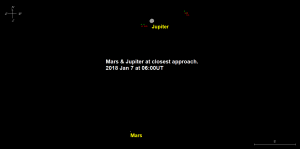2018 January 1
A January Mars Jupiter conjunction in the morning sky
After conjunction with the Sun last October, planetary observers will be relieved to know that Jupiter is now back in the morning sky (like many people, I always feel there is something missing when Jupiter is not around). In early January it rises around 03:30UT and by the start of astronomical sunrise at 06:00 is 17 degrees above the south-eastern horizon. Not to be outdone Mars is also on display, albeit at mag 1.5, so significantly fainter than brilliant mag -1.8 Jupiter.
On January 3 the two planets will be just under 2 degrees apart and if we are lucky enough to have a week of clear skies (or at least a few clear mornings) it will be fascinating to watch Jupiter catch and then overtake Mars as it makes its way towards opposition on May 9 (Mars reaches opposition on July 27). In this game of planetary overtaking Jupiter is 1 degree from Mars on January 5 with the two planets closest on January 7 (a Sunday morning) when only around 15 arcminutes separates them, with Mars lying just south of Jupiter. By the end of the month the separation will have increased to 12 degrees and Saturn (magnitude 0.6) will also have joined them in the morning sky, rising around 05:40UT.
At closest approach on January 7, Jupiter will display a disk diameter of 33 arcsec while tiny Mars only manages just under 5 arcsec. If the weather obliges this close approach could make a stunning observing or imaging opportunity. On this day of closest approach at 06:00UT (see sky chart below), telescopes will show the Galilean moons Ganymede and Calisto lying 4 arcmin to the west of Jupiter and Io and Europa around 1 arcmin to the east. The Moon on this date will be 5 days past full and lying in the south-west. Moving further ahead, on February 7 the last quarter Moon joins in the morning display with Saturn, Mars, Jupiter and the Moon strung out along the ecliptic and even tiny Pluto, perhaps trying to pretend it is still a planet, only just below the eastern horizon!

| The British Astronomical Association supports amateur astronomers around the UK and the rest of the world. Find out more about the BAA or join us. |
